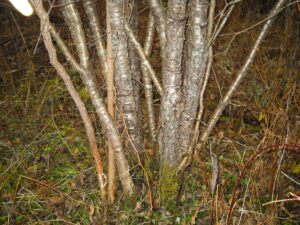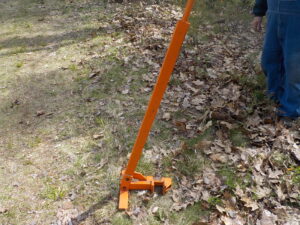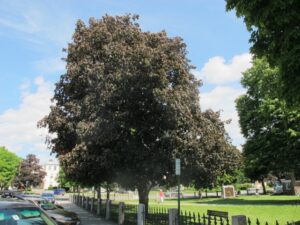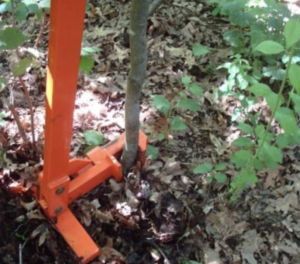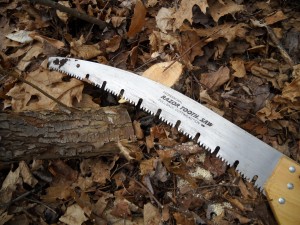Early Spring Chores
If you have a wooded area on your property, it probably needs some help from you, especially if you haven’t done any thinning or grooming of trees in recent years. Start by going outside and really look at the trees growing on your property with a critical eye.
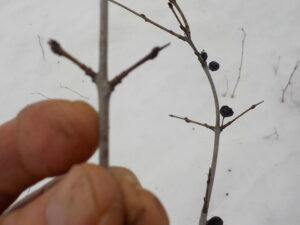
Buckthorns still have black berries and small branches that are sub-opposite (see pair just above my finger) or opposite each other.
Trees that I cull from my woods include poplars (Populus spp.), boxelder (Acer negundo) and alders (Alnus spp.). These are fast-growing trees that are short-lived and that produce lots of seedlings.
To rid your property of buckthorns, you can pull young ones or girdle the older ones. Trees up to about 2.5 inches in diameter can be pulled with a tool designed for that purpose. It is often called a weed wrench, although the original Weed Wrench company has gone out if business. Another brand of weed wrench is called the “Pullerbear”. It is a steel tool with a gripping mouthpiece and a long handle that provides mechanical advantage. They come in several sizes and prices. For more info see www.pullerbear.com. I have not yet tried one of this brand, but they look like the old weed wrenches I have used.
Hemlocks and pines often grow so densely that their lower limbs die out because the sun never reaches their leaves. Removing those lower branches opens up the landscape – another task you could do now. And think about removing any wild grapes that are climbing your trees – they can kill them.
Invasives and What to Do About Them
Since ancient times, explorers have brought back seeds and plants from exotic lands. Some, like the apple, have been a boon to the citizens of their adoptive home. Others, like the notorious Japanese knotweed (a.k.a. “bamboo”) have been more headache than boon.
The Norway maple, for example, is a lovely-looking tree that grows fast and survives well even in urban areas. It will grow in sun or partial shade and is not bothered by road salt. If you have one that is shading your house, I can understand why you might be unwilling to cut it down.
Digging the stump of an invasive shrub like barberry, bush honeysuckle or burning bush is a pain in the neck, but you probably can do it. Digging the stump of a large Norway maple is not practical. But there are folks with back hoes and stump grinders, and the expertise to do it.
Outdoor Work in Early Spring
Before we launch into this week’s article…
Gardening Classes with Henry
Lebanon College: Gardening: A Practical Workshop. Garden writer Henry Homeyer will teach you the basics of organic vegetable and flower gardening. From garden design to seed-starting , planting, watering, weeding, mulching, and harvesting, this course will give each student practical knowledge of gardening. Tuesday nights from 6:30-8:30 for 5 weeks, April 3-May 2.Contact Lebanon College to reserve a spot for this5-part workshop www.lebanoncollege.edu or call 603-448-2445.
AVA Gallery, Lebanon. Henry will teach 3 classes at AVA Gallery this spring. You may sign up for one or all of these workshops:
Sculpting the Living Landscape: Starting Flowers from Seed
April 9; Monday, 6:30–8:30pm; One 2-hour class
Sculpting the Living Landscape: Perfect Perennials for the Upper Valley Garden
April 23; Monday, 6:30–8:30pm; One 2-hour class
Sculpting the Living Landscape: Organic Techniques for Enriching Soil and Managing Pests
May 7; Monday, 6:30–8:30pm; One 2-hour class
For more information go to www.avagallery.org or call 603-448-3117.
Outdoor Work in Early Spring
Despite a spate of warm weather, it’s still early spring. In my world maple sap is running, a little snow is still in the woods and foolish (early bird) robins are losing weight while waiting for the earthworms to surface. It’s still too early to rake my lawn as it’s pretty soggy. My flower beds would suffer from soil compaction if I were to step inside to clean them up. So what can a gardener do?
This is a great time to clean up scrub brush and small trees along stone walls, close to the house and around stately old trees. If you take a look around your property, you will probably see many “volunteer” trees that are growing where they shouldn’t. Now is a good time to snip them back or pull them out before they get large.
Seeds are amazing. Each has the genetic material to create a new plant. They can stay dormant for years, just waiting for the right growing conditions. But they have flaws: they have no eyes – and little common sense. That’s right. A seed will grow wherever ends up, even if it has no chance to reach maturity at its location. So a maple seed may germinate an inch from a mature pine tree, for example. It has no good future there, but it will try anyway. Volunteer trees and shrubs are easy to remove when young. Ideally, you can pull them and they will never come back to bother you again.
There is a tool that can help you do so: the Weed Wrench (www.weedwrench.com). They come in 4 sizes,  from mini to large depending on the size trees you need to remove – and your budget. A Weed Wrench has a mouthpiece that bites down on a trunk, and a steel lever to pull out the culprit using the mechanical advantage of its long arm. They weigh from 5 lbs to 24 pounds and cost between $82 and $189. One might be good investment for your garden club or Scout troop – many people could share it.
from mini to large depending on the size trees you need to remove – and your budget. A Weed Wrench has a mouthpiece that bites down on a trunk, and a steel lever to pull out the culprit using the mechanical advantage of its long arm. They weigh from 5 lbs to 24 pounds and cost between $82 and $189. One might be good investment for your garden club or Scout troop – many people could share it.
But even small trees may have extensive root systems, so if you wish to do a quick-n-easy clean up, go outside with your loppers and get to work. Cut off stems as close to the ground as you can. But be forewarned: many trees will coppice, or send up several new shoots around the stump.
One of the most common invasive shrubs in my neighborhood is the Japanese honeysuckle. It is common along the edges of fields, stonewalls and driveways. A single bush can get to be 10 feet tall and wide. They produce pleasant cream-colored flowers in early summer, and birds like the seeds – which they distribute widely. I cut several big honeysuckles on my property last fall, and just cut off a few more recently. I know they may come back from the roots, but they won’t bloom and produce seeds in their first year, so I am reducing seed production. And if I can remember to cut them back every year or two, I will slow their spread.
Trees compete for nutrients, water and sunlight. If you have an aging maple or other tree that is not in perfect health, cleaning up the scrub around it seems like a logical way to help. Sugar maples, in general, are suffering due to the acid rain that falls here in New England (due to pollutants in the air from coal-burning power plants). Acid rain dissolves calcium in the soil, and allows it to wash away or leach deeper into the soil. Maples in particular suffer when growing in low calcium conditions. So removing vigorous young trees and shrubs from around the maples – their competition – should help.
You can also help your old maples by spreading some limestone around the trees at this time of year. I distribute limestone in a circle about 100 feet in diameter around an aging maple each fall or spring. I don’t do it scientifically, so many pounds per hundred square feet. I just give a light top dressing each year, and know that it helps.
Another reason I get rid of scrub brush is pure aesthetics. Small trees and shrubs distract the eye from the beauty of a stone outcropping or wall. I like simplicity and neatness in my landscape. Scruffy stuff is akin to an unmade bed. Clean it up, and it’s easier to notice the texture of the bark of a mature maple or beech.
Another chore that can be done now is to remove some lower branches of trees alongside your stone wall. In keeping with my desire to simplify the landscape and expose ledge or stonework, I like to cut off branches that I can reach easily – though sometimes I will work up a trunk on a ladder to remove limbs that I cannot reach from the ground. Don’t do maple or birch right now, however, as they will “bleed” sap in quantity.
As much as I enjoy visiting a city, I’m a country boy. I need to go outside most days and do a little work on my landscape. I sometimes wonder if I’ll ever retire from writing so a can putter all day. It’s a temptation.
Henry Homeyer is the author of 4 gardening books. Go to his Web site www.Gardening-Guy.com for more information about gardening. His e-mail is henry.homeyer@comcast.net



